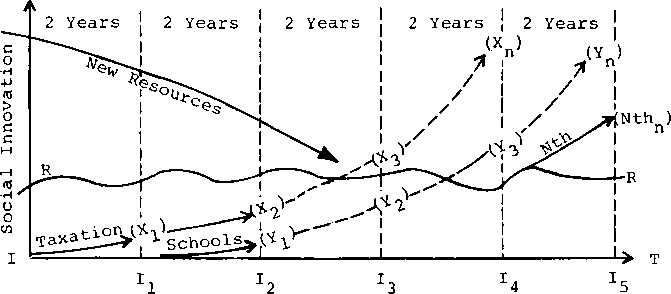S

Technological Innovation
Figure 5. Flow of Resources to New Research and
Educational Functions, Reconceptualization Stage
Act II” (the social innovation research equivalent of the original
Hatch Act) and “Smith-Lever Act II” can build a permanent fiscal
base for these activities in the university as “definite and distinct” re-
search and educational capabilities. The equivalent Hatch Act II and
Smith-Lever Act II would tie in resources with federal agencies
different from their present finkage solely to the Department of
Agriculture.
If all of this has begun to have a familiar ring—it should. This
whole strategy is copied from the process used by the resident faculty,
near the turn of the century, to “move” the land-grant university from
on-campus teaching to teaching people in the countryside, to give them
knowledge for practical application. A “definite and distinct” research
and extension capability became a reality, with funds flowing into the
system from new state and federal legislative acts and grants-in-aid.
We need a major innovation within our system a la the historic
period 1887-1914, which can happen when its time has arrived. We
can profit from the lessons of our recent experience in the modest
though transient success of prototype operations. The experience of
our own illustrious past, and the record of present innovation-oriented
firms can enable us to achieve a research and educational capacity
which is in scale with the demands of people in our society. We can
foster diversity in the style and performance of our university research
and educational functions. To do so will require more than the mar-
ginal increments of faculty time. Some important faculty will need to
devote their time temporarily to articulating and dramatizing the new
23
More intriguing information
1. AN IMPROVED 2D OPTICAL FLOW SENSOR FOR MOTION SEGMENTATION2. Change in firm population and spatial variations: The case of Turkey
3. Types of Tax Concessions for Promoting Investment in Free Economic and Trade Areas
4. The Role of Land Retirement Programs for Management of Water Resources
5. LABOR POLICY AND THE OVER-ALL ECONOMY
6. Credit Markets and the Propagation of Monetary Policy Shocks
7. Examining the Regional Aspect of Foreign Direct Investment to Developing Countries
8. TRADE NEGOTIATIONS AND THE FUTURE OF AMERICAN AGRICULTURE
9. The name is absent
10. The name is absent